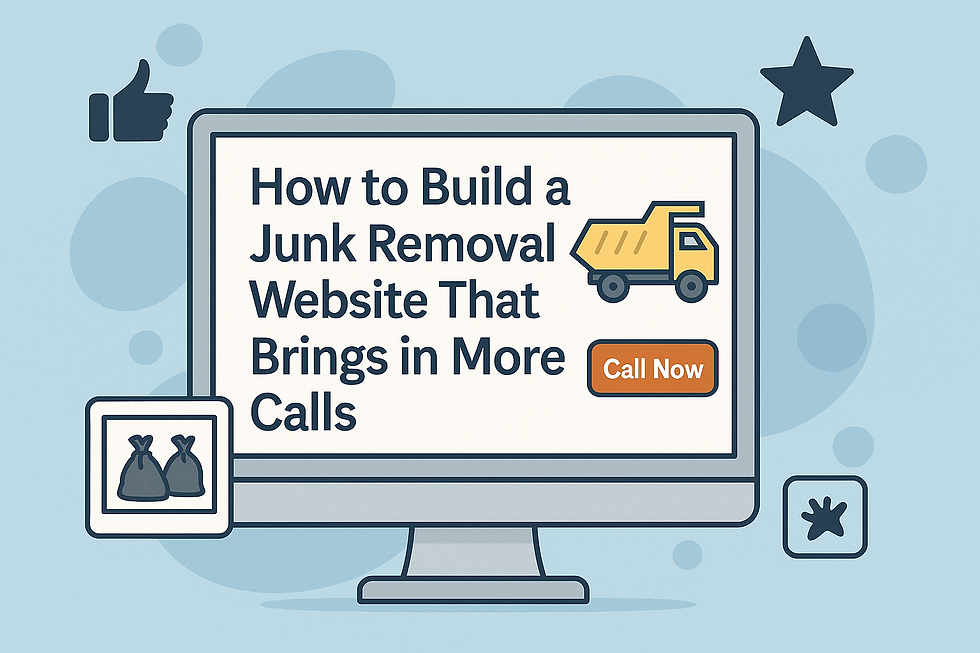How to Build a Handyman Website That Gets You More Jobs (Even If You’re Not a Tech Person)
- Johnathon Crowder
- Aug 8
- 4 min read

Why Your Website Matters More Than You Think
Most people looking for a handyman aren’t “shopping around” for weeks.
They want help fast — often the first handyman who answers and looks trustworthy gets the job.
But here’s the catch: Many handyman websites don’t build that trust.
They’re often:
Missing basic info like services or prices
Buried in text with no clear way to call or book
Designed for a desktop, but a nightmare to use on a phone
Using stock photos instead of real examples of work
That’s why this guide will walk you through how to build a handyman site that actually works — one that turns casual visitors into paying clients.
Step 1: Know Your Ideal Customer and Services
The term “handyman” can cover a lot of ground
.Before you touch a website builder, think about:
What types of jobs do I want more of? (Repairs, small remodels, painting, furniture assembly?)
Who’s my ideal customer? (Busy homeowners? Seniors? Property managers?)
Do I serve residential, commercial, or both?
Knowing this helps you:
Choose the right photos (don’t show kitchen remodels if you don’t do remodels)
Write service descriptions that speak to your ideal customer’s needs
Feature reviews that show you’ve done those jobs before
Example:
If you want more landlord/property manager jobs, highlight “reliable, fast turnaround, and ongoing maintenance packages” instead of just “general handyman services.”
Step 2: Keep the Website Layout Simple and Clear
A handyman website doesn’t need to be fancy — it needs to be fast, clear, and easy to use.
At a minimum, include:
Home – Quick intro, service highlights, and a big Call Now button.
Services & Pricing – A bullet-point list of services with starting prices.
Gallery / Project Photos – Real photos of jobs you’ve done.
Reviews – Short, real quotes from happy customers.
Contact / Book Now – Phone, email, and a simple form.
That’s all you need to start getting calls. More pages can come later.
Step 3: Make It Mobile-First
Over 70% of your visitors will be on their phone — maybe while standing in front of the leaky faucet you’ll be fixing.
Your mobile site should:
Have your phone number right at the top (tap-to-call)
Include a sticky “Call Now” button that follows as they scroll
Load quickly (under 3 seconds)
Show your services clearly without endless scrolling
Test it yourself:If you can’t book your own service on your phone in under 30 seconds, your customers can’t either.
Step 4: Show Real Photos of Your Work
People hire handymen based on trust — and real photos help build it instantly.
What to include:
Before-and-after shots of repairs or installations
Action shots of you working (tools in hand)
Finished projects that look clean and professional
Tips:
Use good lighting (natural if possible)
Avoid messy backgrounds
Wear a consistent shirt or uniform in photos for a professional look
Step 5: Be Transparent About Pricing
One of the top reasons people don’t call is because they can’t find prices.
Even if it’s not exact, “starting at” pricing helps filter out bad leads and builds trust.
Example Pricing Section:
Faucet Replacement – Starting at $85
Ceiling Fan Installation – Starting at $125
Hourly Rate – $65/hr (2-hour minimum)
You can always add, “Final price depends on the job and materials” to cover yourself.
Step 6: Make Contacting You Effortless
Your customers should never have to dig for your phone number.
Best practices:
Put your phone number in the header and footer of every page
Make it clickable on mobile
Offer a quick contact form (Name, Phone, Job Type)
Offer text messaging — many homeowners prefer it
If you can respond quickly, you’ll win more jobs than competitors who wait hours to reply.
Step 7: Use Reviews Everywhere
A great review is worth more than any ad copy.
Don’t just stick them on a “Reviews” page — sprinkle them throughout your site:
One or two under your intro on the homepage
Next to your “Book Now” button
On your services page (matched to the job type)
Example:
“John fixed my fence the same day I called. Friendly, fast, and reasonably priced — will hire again!” – Susan T., Springfield MO
Step 8: Be Clear About Your Service Area
If people don’t see their city, they may not call.
Make your location visible:
In your homepage headline (Handyman Services in Springfield, MO and Nearby Areas)
In your footer
On your contact page
In your Google Business Profile
If you serve multiple towns, list them all in a bullet point list on your homepage.
Step 9: Keep It Updated
A stale site makes people think you might be out of business.
Update it regularly by:
Adding new project photos
Refreshing seasonal specials
Posting quick “handyman tips” to show you’re active and knowledgeable
Step 10: Know When to Get Professional Help
You can DIY your site — but most handymen are too busy fixing things to worry about design, speed, and SEO.
That’s where Crowder Code & Design comes in:
We build mobile-friendly handyman websites that load fast
Add trust-builders like reviews, galleries, and pricing
Optimize for local searches so you show up when people Google “handyman near me”
Keep it updated so you can focus on your jobs, not your website
Final Takeaway
Your website isn’t just a brochure — it’s your digital handshake with every new customer.
A strong handyman website:
Shows what you do and proves you’re good at it
Makes it easy to contact you
Builds trust with reviews and real work photos
Works perfectly on mobile
Do those things, and you’ll get more jobs without spending a dime more on advertising.
If you want a free custom video audit of your current site — showing exactly what’s working and what’s costing you calls — click here and I’ll send it straight to your inbox.
No jargon, just real tips you can use.




Comments